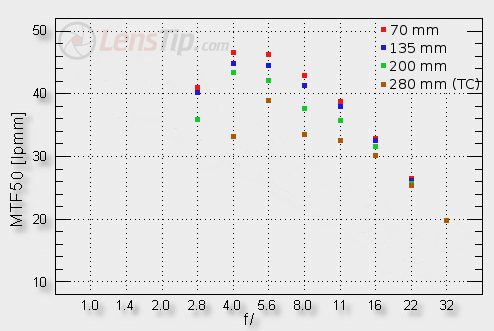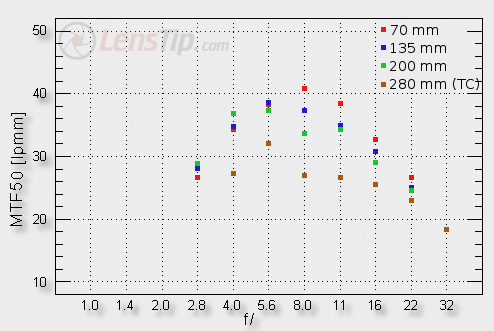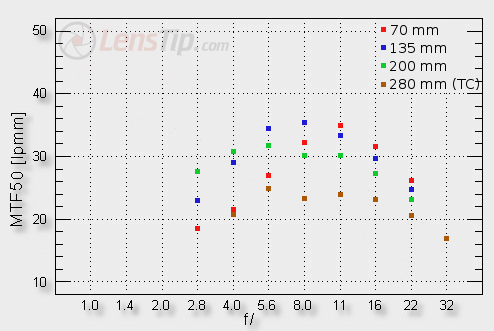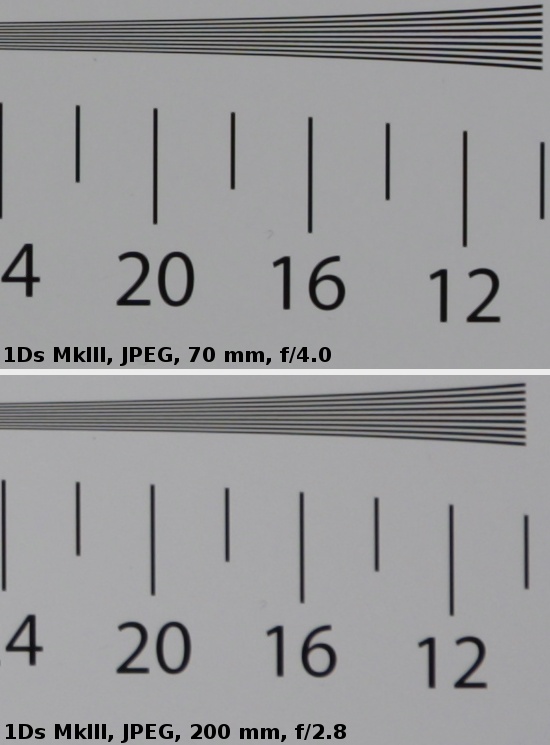Sigma 70-200 mm f/2.8 EX DG APO OS HSM
4. Image resolution
It’s worth reminding here that the best fixed-focal lenses, tested on the 1 Ds. MkIII, reach MTF50 values as high as 46-47 lpmm. In the case of the tests conducted on that body the decency level we place near 30-31 lpmm. Let’s check how the tested Sigma fared in the frame centre, taking all this info into account. The appropriate crops for individual focal lengths are presented on the graph below.

Please Support UsIf you enjoy our reviews and articles, and you want us to continue our work please, support our website by donating through PayPal. The funds are going to be used for paying our editorial team, renting servers, and equipping our testing studio; only that way we will be able to continue providing you interesting content for free. |
- - - - - - - - - - - - - - - - - - - - - - - - - - - - - - - - - - - - - - - - - - - - - - - -
The results the tested lens had in the 70-135 mm range are simply splendid. Already at the maximum relative aperture the MTF50 values slightly exceed 40 lpmm and by f/4.0 and f/5.6 the lens performs like a good “prime” going up to 45-46.5 lpmm. These results are virtually identical with those of the Nikkor 70-200 mm VR II tested lately.
The 200 mm focal length lags behind the 70-135 mm range a bit. Still it would be hard to criticize it. Even at the maximum relative aperture MTFs go as high as almost 36 lpmm so we get a crisp and sharp image there. On further stopping down the lens exceed the level of 40 lpmm without any problems. Here, however, the Nikkor prevails slightly over the Sigma. As at 200 mm and by f/2.8 both instruments fare alike within the margin of error, by other apertures the Nikkor’s performance matches that of the 70-135 mm range and the Sigma lags behind, having the weakest results at 200 mm.
If a lens goes through a crisis at the maximum focal length, after attaching a converter the problem usually becomes only worse. This time the situation not different but you must admit the results at 280 mm are still fully useful and acceptable. Even at the maximum relative aperture the lens with the converter attached doesn’t find it difficult to exceed the 30 lpmm level. Practically no older 70-200 mm f/2.8 construction managed to do that.
It’s also worth noticing that the performance of the new Sigma 70-200 mm OS in the frame centre is significantly and in every respect better than that of its both predecessors.
Let’s get down to discussing how the lens fared on the edge of the APS-C/DX sensor. The appropriate graph you can find below.

As you can see the lens almost reaches the borderline of 30 lpmm at all focal lengths even wide open. On slight stopping down we see that borderline exceeded and the images become fully useful. By apertures ranging from f/5.6 to f/8.0 MTFs increase to very good values - the level of 37-40 lpmm. The combination of 200 mm focal length and f/8.0 aperture is an exception here, but we are going to say more about it in a moment. The results are a bit worse than those of the Nikkor which also didn’t exceed 40 lpmm distinctly but performed more evenly and reached that borderline at almost all focal lengths.
The quite significant worsening of the image on the frame edge is a characteristic feature of teleconverters cooperating with zoom lenses. We deal with such an effect also in this case. By and large you can recommend using only f/4.0 and f/5.6 apertures (fortunately the most useful anyway) because by others the image at the edge becomes simply weak.
Now, let’s check how the lens fares at the edge of full frame. The graph below will help us to do so.

Here we witness far more troubles. At the maximum relative aperture we don’t reach the decency level at any focal length. Especially the 70 mm result makes a mediocre impression – we must stop the lens down by more than 2 EV to obtain a tolerably focused image in the whole field of view. We are not surprised, though. The collapse of focus on the same frame edge at this focal length exactly can be noticed even on MTF graphs presented by the producer. Fortunately, in the case of the 135-200 mm range, on stopping down by about 1 EV we can finally enjoy an acceptable level of resolution even at the edge of full frame.
Even more problems we encounter in the case of the lens-plus-converter set. The 30 lpmm decency level is not reached at any aperture and it simply means that for this combination the frame edge can be used only as a nicely blurred background, not an area of sharp images.
Inquisitive readers might notice an interesting collapse of the resolution graph, visible at 200-280 mm focal lengths and by f/5.6 and f/8.0 apertures. This is the combined influence of two off-axis aberrations – the astigmatism and the lateral chromatic aberration. At these apertures exactly the chromatic aberration starts to increase and the astigmatism changes a bit its graph across the frame, leading to such an effect. It is important because if you conduct tests only and solely on vertical (or horizontal) borderlines you won’t detect it. Telling so we try to anticipate potential questions which might arise if somebody starts to compare our results with those published in other tests.
We would like to add that you can exclude a hypothesis about measurement errors being the source of such a performance. It was visible independently on two separate testing charts and at two focal lengths (200 and 280 mm) so in four independent combinations. There is little chance that this effect was accidental, then.
 |






